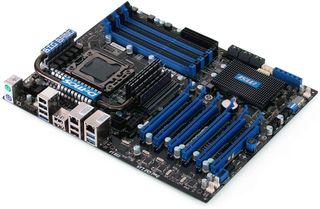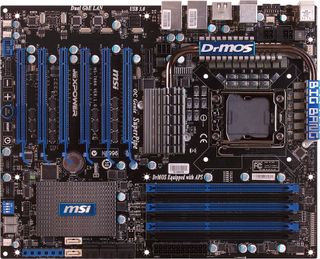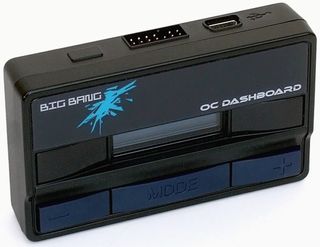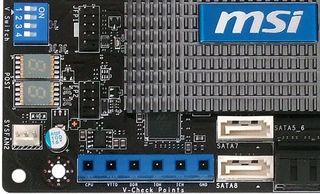X58 To The Max: Three New Flagship LGA 1366 Motherboards
Supporting Intel’s highest-performance processors with twice the bandwidth of its mainstream counterpart, the X58 chipset proves the staying power of good ideas. We take a closer look at what makes the latest generation of premium motherboards special.
MSI Big Bang-XPower
As the epitome of MSI’s Big Bang series, its XPower motherboard attempts to combine most of Gigabyte’s connectivity with some of Asus’ overclocking features at a price that undercuts both competitors. Examples of this effort include its six x16-length PCIe 2.0 slots (compared to Gigabyte’s seven), dual-gigabit networking (offered by Gigabyte, but not by Asus), and an external overclocking capability (offered by Asus but not by Gigabyte).

A lower price certainly doesn’t make the Big Bang-XPower cheap, and this $300 model includes the same USB 3.0 and SATA 6Gb/s controllers used by both competitors. All three of today’s contenders use dual eight-pin CPU power regulator inputs to differentiate themselves from lower-amperage designs, but MSI filters the power coming out of its 16-phase regulator with purportedly higher-quality Hi-c flat capacitors.

However, being all things to all people is an impossible task. Maintaining a lower price meant leaving out any of the PCIe bridges used by Gigabyte to multiply its PCIe lanes, forcing MSI to instead divide the Big Bang-XPower’s pathways in a similar manner compared to Asus' design. Yet Asus has only four slots, making lane division a simple matter of going from dual-x16 to quad-x8 transfers whenever the second and fourth slots are filled. MSI splits slot connectivity first to x8 mode and then to x4 mode to accomplish lane division across six slots.
It’s at this point where MSI had to decide whether to optimize its slot layout for dual- or triple-card graphics arrays, since performance graphics cards are usually dual-slot designs. MSI put the XPower motherboard’s true x16 slots in positions one and four, a design that leaves extra space beneath double-slot cards for added airflow and even allows the use of triple-slot cards like the Asus ARES. Slots three and five take eight lanes each from slots one and four, while slots two and six take four lanes from slots three and five. The end result is that fitting a three-way graphics array into long slots one, three, and five produces an x8-x8-x8 configuration with eight-lanes wasted. Oops!
Optimizing both two- and three-way arrays would have required lane arrangements of x16-x4-x8 (for long slots one-two-three) and x4-x16-x8 (for long slots four-five-six). But such an arrangement would also have required a case to have some added space beneath the motherboard's bottom edge when installing two triple-slot cards in the 16-lane slots.

Competitive overclockers could be the true target market for MSI’s XPower, and MSI caters to them with multiple clock-control access methods, voltage-cap unlocking switches, a POST code display, and several line-voltage detection points. The OC Genie button above can be set to enable reference clock control through the touch sensors to its left, for example.

MSI’s OC Dashboard controls multiple clocks from outside the box, plugging into the I/O panel through included cables. This allows overclockers to tune their system while Windows is running, without adding pesky software solutions.
Stay on the Cutting Edge
Join the experts who read Tom's Hardware for the inside track on enthusiast PC tech news — and have for over 25 years. We'll send breaking news and in-depth reviews of CPUs, GPUs, AI, maker hardware and more straight to your inbox.

We’re particularly fond of the XPower’s V-Check Points design, as its plastic shell holds the probes of our voltage meters perfectly. Further evidence of the board’s two-way graphics intentions is found in the placement of its two SATA 6Gb/s ports. The fourth x16-length slot is one of only two to have the full 16 pathways and any long graphics card installed there slips under these connectors.


MSI’s audio riser card fits into the board’s solitary PCIe x1 slot, using Realtek’s ALC889 codec and Creative Labs EAX Advanced HD 5.0 and Alchemy software packages to provide advanced audio features. This particular module has been modified from its previous incarnation by removing a metal tab from its cover, increasing clearance for motherboard components.

Six internal SATA cables beef up an installation kit that’s been otherwise fluffed with pamphlets. Three SLI and one CrossFire bridge ease multi-GPU installations, and users who need additional eSATA ports will be happy to find a breakout plate with power and data cables to add internal drives externally.
Current page: MSI Big Bang-XPower
Prev Page GA-X58A-UD9 Overclocking Utilities Next Page Big Bang-XPower BIOS-
one-shot No EVGA SR-2? :(Reply
Ok, Hold on. Three Flagship LGA 1366 Boards and no overclocked power consumption results? These boards are obviously made for overclocking and those results would be very interesting to see. -
Lmeow Reply9498281 said:No EVGA SR-2? :(
The EVGA Classified SR-2 is based on the Intel 5520 chipset and uses Xeons, so it's not an X58 board technically speaking which is why it doesn't qualify. ;)
If I could spend that much on a motherboard I'd have chosen the Rampage III Extreme, not only does it have good features it also has the best colour scheme. ^^
Does anyone know why I try to submit a comment it doesn't show up, and I have to use the forums instead to post a comment instead? -
sudeshc I am totally impressed by ASUS they always come up with best solution in every category, but the price is a killer for me :(Reply
-
rottingsheep IMO, the only interesting part about motherboard reviews is the overclocking and power consumption portion.Reply -
avatar_raq Nice article..I have only catch: Of all the mobos tested, Quad SLI is not possible on the ASUS R3E, courtesy of nVIDIA's driversReply
http://www.guru3d.com/news/quad-sli-on-asus-rampage-iii-extreme-is-not-possible/ -
dragonfang18 Whats the point when Intel will come out with new processors with different sockets next year?Reply -
Crashman avatar_raqNice article..I have only catch: Of all the mobos tested, Quad SLI is not possible on the ASUS R3E, courtesy of nVIDIA's drivershttp://www.guru3d.com/news/quad-sl -possible/Awesome, thanks. Manufacturers don't actually discuss this stuff.Reply
dragonfang18Whats the point when Intel will come out with new processors with different sockets next year?That's what people like you were saying months before LGA 1156 was released. We see which direction that went. -
dragonfang18 ReplyThat's what people like you were saying months before LGA 1156 was released. We see which direction that went.
Yeah... they are changing 1366 to some socket R... Well... At least I can look forward to these motherboards going down in price by next year when they go to Socket R's for performance than 1366's. I guess ill be happy with 1366's. Hopefully they go down by at least $100.
Most Popular


